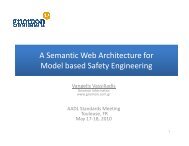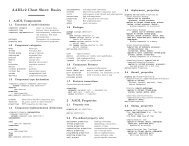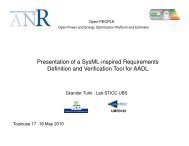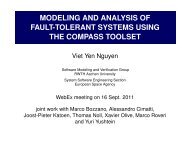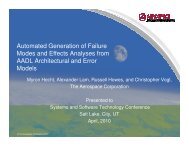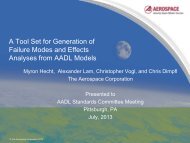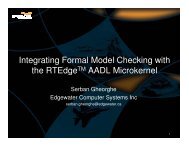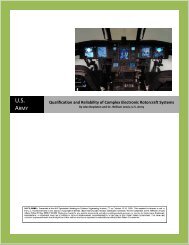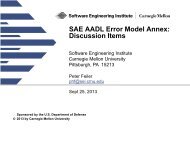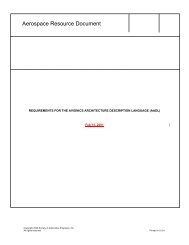Compositional Analysis of Avionics Architectures in AADL DARPA ...
Compositional Analysis of Avionics Architectures in AADL DARPA ...
Compositional Analysis of Avionics Architectures in AADL DARPA ...
You also want an ePaper? Increase the reach of your titles
YUMPU automatically turns print PDFs into web optimized ePapers that Google loves.
<strong>Compositional</strong> <strong>Analysis</strong> <strong>of</strong> <strong>Avionics</strong><strong>Architectures</strong> <strong>in</strong> <strong>AADL</strong><strong>DARPA</strong> TTO / META<strong>AADL</strong> Committee16 April 2012Darren C<strong>of</strong>er© Copyright 2011 Rockwell Coll<strong>in</strong>s, Inc.All rights reserved.
Outl<strong>in</strong>e• What is META?• Project vision• Tool environment• Technologies– System-level model<strong>in</strong>g and translation– Complexity-reduc<strong>in</strong>g architectural patterns– <strong>Compositional</strong> verification and demo• Next steps© Copyright 2011 Rockwell Coll<strong>in</strong>s, Inc.All rights reserved.2
Team• Rockwell Coll<strong>in</strong>s / Advanced Technology Center– Darren C<strong>of</strong>er, Steven Miller, Andrew Gacek– System model<strong>in</strong>g & analysis, tool<strong>in</strong>g, <strong>in</strong>tegration• UIUC– Lui Sha– Design pattern development• University <strong>of</strong> MN– Michael Whalen– Pattern verification, compositional analysis• WWTG– Chris Walter, Brian LaValley– Pattern implementation & analysis tools© Copyright 2011 Rockwell Coll<strong>in</strong>s, Inc.All rights reserved.3
META is part <strong>of</strong> the <strong>DARPA</strong> AVM program© Copyright 2011 Rockwell Coll<strong>in</strong>s, Inc.All rights reserved.4
What is META?• Devise, implement, and demonstrate a radically different approach to the design,<strong>in</strong>tegration/manufactur<strong>in</strong>g, and verification <strong>of</strong> defense systems/vehicles• Enhance designer’s ability to manage system complexity• “Foundry-style” model <strong>of</strong>manufactur<strong>in</strong>g• Five technical areas1. Metrics <strong>of</strong> complexity2. Metrics <strong>of</strong>adaptability3. Meta-language forsystem design4. Design flow & tools5. Verification flow &tools© Copyright 2011 Rockwell Coll<strong>in</strong>s, Inc.All rights reserved.5
Vision• Improve effectiveness and scalability <strong>of</strong> system design andverification through pre-verified design patterns andcompositional reason<strong>in</strong>gVOTEMULTIPLEDATASENSOR 1SENSOR 2SENSOR 3LRUCOMPUTINGRESOURCE ACOMPUTINGRESOURCECOMPUTINGRESOURCE BFAIL-SILENTNODE FROMREPLICASABSTRACTIONVERIFIEDAVAILABILITYARCHITECTUREMODELCOMPOSITIONAL PROOF OF CORRECTNESS(ASSUME – GUARANTEE)VERIFIEDINTEGRITYVERIFICATIONREUSESAFETY, BEHAVIORAL,PERFORMANCE PROPERTIESCOMPOSITION© Copyright 2011 Rockwell Coll<strong>in</strong>s, Inc.All rights reserved.6
ApproachARCHPATTERNMODELSINSTANTIATEARCH PATTERNS& CHECKCONSTRAINTSComplexity-reduc<strong>in</strong>g design patterns• Capture best solutions to architecturaldesign problems• Reuse <strong>of</strong> formally verified solutions• Increase level <strong>of</strong> design abstraction 2ANNOTATE& VERIFYMODELSPATTERN &COMP SPECLIBRARYSYSTEMMODELINGENVIRONMENTSYSTEMMODEL(<strong>AADL</strong>)AUTOGENERATESYSTEMIMPLEMENTATIONCOMPONENTMODELSCOMPONENTLIBRARYCOMPOSITIONALREASONING &ANALYSISDesign FlowSPECIFICATION SYSTEM DEVELOPMENT FOUNDRYSystem architecture model<strong>in</strong>g• Apply formal specification and analysistools to system-level design• Separate component specification andimplementation• Automated model translation 1<strong>Compositional</strong> verification• Reason about system behaviorbased on contracts and systemdesign model structure• <strong>Compositional</strong> approach scales tolarge s<strong>of</strong>tware systems3© Copyright 2011 Rockwell Coll<strong>in</strong>s, Inc.All rights reserved.7
Tool cha<strong>in</strong>SysMLSysML-<strong>AADL</strong>translationOSATE:<strong>AADL</strong> model<strong>in</strong>gEnterpriseArchitect<strong>AADL</strong>LustreEDICT:ArchitecturalpatternsLute:StructuralverificationAGREE:<strong>Compositional</strong>behavior verificationEclipseKIND© Copyright 2011 Rockwell Coll<strong>in</strong>s, Inc.All rights reserved.8
System architecture model<strong>in</strong>g• We have been very successful at apply<strong>in</strong>g formal methods tos<strong>of</strong>tware components produced <strong>in</strong> model-based developmentenvironments– Gryphon translation framework– Verification <strong>of</strong> Simul<strong>in</strong>k/Stateflow models• ObjectiveSimul<strong>in</strong>k– Leverage this knowledge andapply formal methods to thesystem design process• Issues– Model<strong>in</strong>g language and tools– Different models <strong>of</strong> computation– ScalabilityStateFlowSimul<strong>in</strong>kGatewaySimul<strong>in</strong>kGatewaySCADEReactisSafe StateMach<strong>in</strong>esRockwell Coll<strong>in</strong>s/U <strong>of</strong> M<strong>in</strong>nesotaEsterel TechnologiesSRI InternationalMathWorksReactive SystemsLustreModel Checkers:NuSMV, Prover,BAT, K<strong>in</strong>d, SALTheorem Provers:ACL2, PVSProgramm<strong>in</strong>gLanguages:SPARK (Ada), CDesignVerifier© Copyright 2011 Rockwell Coll<strong>in</strong>s, Inc.All rights reserved.9
System model<strong>in</strong>g and translation• <strong>AADL</strong> is a good fit and provides sufficiently formal notation– Available tools do not provide stable graphical environment– OSATE: open source, Eclipse-based• SysML is be<strong>in</strong>g adopted by many organizations for system design– But has no formal semantics– No common textual representation across tools• Solution: Eclipse plug<strong>in</strong> that provides bidirectional translation– Based on Enterprise Architect SysML tool used by Rockwell Coll<strong>in</strong>s– Def<strong>in</strong>e block stereotypes that correspond to <strong>AADL</strong> objects© Copyright 2011 Rockwell Coll<strong>in</strong>s, Inc.All rights reserved.10
Scale and composition• Architectural model does not capture implementation details– Component descriptions, <strong>in</strong>terfaces, <strong>in</strong>terconnections• Assume/guarantee contracts provide the <strong>in</strong>formation neededfrom other model<strong>in</strong>g doma<strong>in</strong>s to reason about system-levelproperties– Guarantees correspond to the component requirements– Assumptions correspond to the environmental constra<strong>in</strong>ts that wereused <strong>in</strong> prov<strong>in</strong>g the component requirements– Contract specifies precisely the <strong>in</strong>formation that is needed to reasonabout the component’s <strong>in</strong>teraction with other parts <strong>of</strong> the system– Supports hierarchical decomposition <strong>of</strong> verification process• Contract can be applied to both components and designpatterns– Mechanism for verification reuse– More about this later© Copyright 2011 Rockwell Coll<strong>in</strong>s, Inc.All rights reserved.
PALS i i + 1 i i + 1 ReplicationNODE 1NODE 1NODE 2NODE 2share <strong>in</strong>putsmerge outputsNODE 3TNODE 3CLOCK JITTERSYNCHRONOUS NETWORK• Provide virtual synchrony for parts <strong>of</strong> async system• Assumptions– Structural preconditions on system model (boundedjitter, computation, message delivery…)– Required data connections exist• Guarantees– Sync logic executes with period T– Data from step i consumed <strong>in</strong> step i +1Leader Selection© Copyright 2011 Rockwell Coll<strong>in</strong>s, Inc.All rights reserved.ASYNCHRONOUS BOUNDED DELAY NETWORK WITH PALS• Create leader for group <strong>of</strong>nodes• Assumptions– Nodes communicatesynchronously– At least one nonfailednode• Guarantees– All non-failed nodesagree on leader– If leader fails, newleader <strong>in</strong> next step– Non-failed noderema<strong>in</strong>s leader• Create identical copies <strong>of</strong> portions <strong>of</strong> the system• Assumptions– Replicas hosted on platform HW with <strong>in</strong>dependentfailure modes• Guarantees– One or replicas will operate normally <strong>in</strong> the event <strong>of</strong>a s<strong>in</strong>gle faultVot<strong>in</strong>g/Fusion• Comb<strong>in</strong>e several component <strong>in</strong>terfaces• Assumptions– Interfaces term<strong>in</strong>ate at same dest<strong>in</strong>ation component– Interfaces have same data type• Guarantees– Varies with component type– Agreement, mid-value select, output select, average
Initial <strong>Avionics</strong> System© Copyright 2011 Rockwell Coll<strong>in</strong>s, Inc.All rights reserved.13
F<strong>in</strong>al <strong>Avionics</strong> System (after pattern transformations)© Copyright 2011 Rockwell Coll<strong>in</strong>s, Inc.All rights reserved.14
System verification3SPECIFICATION SYSTEM DEVELOPMENT FOUNDRYARCHPATTERNMODELSINSTANTIATEARCHITECTURALPATTERNSANNOTATE& VERIFYMODELSPATTERN &COMP SPECLIBRARYSYSTEMMODELINGENVIRONMENTSYSTEMMODELAUTOGENERATESYSTEMIMPLEMENTATIONCOMPONENTMODELSCOMPONENTLIBRARYCOMPOSITIONALREASONING &ANALYSISReusable Verification:Pro<strong>of</strong> <strong>of</strong> component and patternrequirements (guarantees) andspecification <strong>of</strong> context(assumptions)Instantiation:Check structural constra<strong>in</strong>ts,Embed assumptions &guarantees <strong>in</strong> system model<strong>Compositional</strong> Verification:System properties are verifiedby model check<strong>in</strong>g us<strong>in</strong>gcomponent & patterncontracts© Copyright 2011 Rockwell Coll<strong>in</strong>s, Inc.All rights reserved.15
Categories <strong>of</strong> system properties• Structural/static– Properties <strong>of</strong> the transformed model– Pattern assumptions, post-conditions– Specified and checked us<strong>in</strong>g Lute– PALS period constra<strong>in</strong>tDeadl<strong>in</strong>e < PALS_Period - Max_Latency - 2*Clock_Jitter• Behavioral/dynamic– Pattern and component <strong>in</strong>teractions– Specified <strong>in</strong> PSL, verified by AGREE us<strong>in</strong>g model check<strong>in</strong>g– Failed node will not be leader <strong>in</strong> next stepG(!device_ok[j] -> X(leader[i] != j)) ;• Resource allocation– RT schedulability, memory allocation, bandwidth allocation– ASIIST tool (UIUC/RC)– Threads can be scheduled to meet their deadl<strong>in</strong>es• Probabilistic– Failure analysis <strong>of</strong> system– Behavior and failure rates described us<strong>in</strong>g <strong>AADL</strong> error annex– PRISM/PRISMATIC (SIFT/RC)– P(all sensors failed) < 10 -9© Copyright 2011 Rockwell Coll<strong>in</strong>s, Inc.All rights reserved.16
Structural/static properties• S<strong>of</strong>tware + HW platform– Process, thread, processors, bus• Ex: PALS vertical contract– PALS tim<strong>in</strong>g constra<strong>in</strong>ts onplatform– Check <strong>AADL</strong> structural properties• Guarantees– Sync logic executes atPALS_Period– Synchronous_Communication=> “One_Step_Delay”• Assumptions (about platform)– Causality constra<strong>in</strong>t:M<strong>in</strong>(Output time) ≥ 2ε – μm<strong>in</strong>– PALS period constra<strong>in</strong>t:Max(Output time) ≤ T - μmax - 2εS<strong>of</strong>twarePlatform© Copyright 2011 Rockwell Coll<strong>in</strong>s, Inc.All rights reserved.17
Structural property checks• Contract– Platform model satisfiesPALS assumptions• Attached at pattern<strong>in</strong>stantiation– Model-<strong>in</strong>dependent– Assumptions– Pre/post-conditions• Lute theorems– Based on REAL– Eclipse plug-<strong>in</strong>– Structural properties <strong>in</strong><strong>AADL</strong> modelPALS_Threads := {s <strong>in</strong> Thread_Set | Property_Exists(s,"PALS_Properties::PALS_Id")};PALS_Period(t) := Property(t, "PALS_Properties::PALS_Period");PALS_Id(t) := Property(t, "PALS_Properties::PALS_Id");PALS_Group(t) := {s <strong>in</strong> PALS_Threads | PALS_Id(t) = PALS_Id(s)};Max_Thread_Jitter(Threads) :=Max({Property(p, "Clock_Jitter") for p <strong>in</strong> Processor_Set |Card<strong>in</strong>al({t <strong>in</strong> Threads | Is_Bound_To(t, p)}) > 0});Connections_Among(Set) :={c <strong>in</strong> Connection_Set | Member(Owner(Source(c)), Set) andMember(Owner(Dest<strong>in</strong>ation(c)), Set)};theorem PALS_Period_is_Periodforeach s <strong>in</strong> PALS_Threads docheck Property_Exists(s, "Period") andPALS_Period(s) = Property(s, "Period");end;theorem PALS_Causalityforeach s <strong>in</strong> PALS_Threads doPALS_Group := PALS_Group(s);Clock_Jitter := Max_Thread_Jitter(PALS_Group);M<strong>in</strong>_Latency := M<strong>in</strong>({Lower(Property(c, "Latency")) forc <strong>in</strong> Connections_Among(PALS_Group)});Output_Delay := {Property(t, "Output_Delay") for t <strong>in</strong> PALS_Group};check (if 2 * Clock_Jitter > M<strong>in</strong>_Latency thenM<strong>in</strong>(Output_Delay) > 2 * Clock_Jitter - M<strong>in</strong>_Latencyelsetrue);end;© Copyright 2011 Rockwell Coll<strong>in</strong>s, Inc.All rights reserved.18
Contracts between patterns and components• <strong>Avionics</strong> system requirementUnder s<strong>in</strong>gle-fault assumption, GCoutput transient response is bounded<strong>in</strong> time and magnitude• Relies upon– Guarantees provided bypatterns and components– Structural properties <strong>of</strong>model– Resource allocation feasibility– Probabilistic system-levelfailure characteristicsBehaviorsynchronouscommunicationStructuretim<strong>in</strong>gconstra<strong>in</strong>ts<strong>Avionics</strong>SystemPALSLSRepleader transitionboundedone nodeoperationalnotco-locatedASSUMPTIONSGUARANTEESPr<strong>in</strong>cipled mechanism for“pass<strong>in</strong>g the buck”ResourcePlatformProbabilistic© Copyright 2011 Rockwell Coll<strong>in</strong>s, Inc.All rights reserved.RT sched& latencyErrormodel19
<strong>Compositional</strong> behavior verification• Given– Assumptions for system– Assumptions/Guarantees for components (A, P)• Prove– System guarantees (requirements)• New analysis plug-<strong>in</strong> (AGREE)– Automatic translation <strong>of</strong> model structure, contracts, and verificationconditions– Verify via k-<strong>in</strong>duction model checker (KIND - T<strong>in</strong>elli @ Univ. <strong>of</strong> Iowa)Contract compliance:G(H(A) P)ACExample (to prove)A S A AA S P A A BA S P A P B A CA S P A P B P C P SAssumption: Input < 20Guarantee: Output < 2*InputBAssumption: noneGuarantee: Output = Input1+ Input2Assumption: Input < 10Guarantee: Output < 50Assumption: Input < 20Guarantee: Output < Input + 15© Copyright 2011 Rockwell Coll<strong>in</strong>s, Inc.All rights reserved.20
Contract specification <strong>in</strong> <strong>AADL</strong>• Derived from PropertySpecification Language(PSL) formalism– IEEE standard– In wide use forhardware verification• Assume / Guaranteestyle specification– Assumptions: “Underthese conditions”– Guarantees: “…thesystem will do X”• Local def<strong>in</strong>itions canbe created to simplifyproperties• For now, this is an<strong>AADL</strong> str<strong>in</strong>g propertyContract:fun abs(x: real) : real = if (x > 0) then x else -x ;const ADS_MAX_PITCH_DELTA: real = 3.0 ;const FCS_MAX_PITCH_SIDE_DELTA: real = 2.0 ;const CSA_MAX_PITCH_DELTA: real = 5.0 ;const CSA_MAX_PITCH_DELTA_STEP: real = 5.0 ;property AD_L_Pitch_Step_Delta_Valid =true ->abs(AD_L.pitch.val - prev(AD_L.pitch.val, 0.0)) < ADS_MAX_PITCH_DELTA ;property AD_R_Pitch_Step_Delta_Valid =true ->abs(AD_R.pitch.val - prev(AD_R.pitch.val, 0.0)) < ADS_MAX_PITCH_DELTA ;property Pitch_lr_ok =abs(AD_L.pitch.val - AD_R.pitch.val) < FCS_MAX_PITCH_SIDE_DELTA ;property some_fgs_active =(FD_L.mds.active or FD_R.mds.active) ;active_assumption: assume some_fgs_active ;transient_assumption :assume AD_L_Pitch_Step_Delta_Valid andAD_R_Pitch_Step_Delta_Valid and Pitch_lr_ok ;transient_response_1 :assert true -> abs(CSA.CSA_Pitch_Delta) < CSA_MAX_PITCH_DELTA ;transient_response_2 :assert true ->abs(CSA.CSA_Pitch_Delta - prev(CSA.CSA_Pitch_Delta, 0.0))
<strong>Compositional</strong> reason<strong>in</strong>g for FCS• Want to prove a transient responseproperty– The autopilot will not cause a sharpchange <strong>in</strong> pitch <strong>of</strong> aircraft.– Even when one FGS fails and the otherassumes control• Given assumptions about theenvironment– The sensed aircraft pitch from the airdata system is with<strong>in</strong> some absolutebound and doesn’t change too quickly– The discrepancy <strong>in</strong> sensed pitchbetween left and right side sensors isbounded.• and guarantees provided bycomponents– When a FGS is active, it will generatean acceptable pitch rate• As well as facts provided by patternapplication– Leader selection: at least one FGS willalways be active (modulo one“failover” step)© Copyright 2011 Rockwell Coll<strong>in</strong>s, Inc.All rights reserved.ibd [SysML Internal Block] Flight_Control_System_Impl [Flight_Control_System]FD_LAD_LAH_LFM_LNAV_LADLtoFGSLAHLtoFGSLFMLtoFGSLNAVLtoFGSLTHROT_LTHROTL2FCIYOKE_LFGSLtoFDLADAHVNAVNAVYOKEL2FCIGCFGS_L : Flight_Guidance_SystemFCITHROT_LYOKE_LCSAFlight_Control_System_ImplAP2CSAFGSLtoAPLSDLSIFCItoFGSLGC_LCSAAP : Autopilot_SystemFGSLtoFGSRFGSRtoFGSLFCIGC_RFCI : Flight_Crew_InterfaceFGSRtoAPFCItoFGSRLSILSDGCFGS_R : Flight_Guidance_SystemTHROT_RYOKE_RFCIFGSRtoFDRADAHVNAVNAVYOKER2FCITHROTR2FCIYOKE_RFlight_Control_SystemADRtoFGSRAHRtoFGSRFMRtoFGSRNAVRtoFGSRtransient_response_1 : assert true ->abs(CSA.CSA_Pitch_Delta) < CSA_MAX_PITCH_DELTA ;transient_response_2 : assert true ->abs(CSA.CSA_Pitch_Delta - prev(CSA.CSA_Pitch_Delta, 0.0))< CSA_MAX_PITCH_DELTA_STEP ;THROT_R22FD_RAD_RAH_RFM_RNAV_R
<strong>Compositional</strong> Reason<strong>in</strong>g and Patternspattern_<strong>in</strong>stance Leader_Select_1 :• Guarantees provided bypattern are encoded asfacts• Attached at pattern<strong>in</strong>stantiation– Model-<strong>in</strong>dependent– Assumptions– Pre/post-conditions• Describe relationshipsbetween severalcomponents– In this example, theLeader and Valid fieldsfor the left and rightFGSs.© Copyright 2011 Rockwell Coll<strong>in</strong>s, Inc.All rights reserved.-- sync s<strong>in</strong>gle-step delay between elementsassume s<strong>in</strong>gle_step_delay_comm(FGS_L, FGS_R);assume s<strong>in</strong>gle_step_delay_comm(FGS_R, FGS_L);-- All non-failed nodes agree on who is the leaderleader_agreement:assert (FGS_L.LSO.Valid and FGS_R.LSO.Valid) =>FGS_L.LSO.Leader = FGS_R.LSO.Leader;-- If a node fails, leadership is transferred to a non-failed nodeleader_transfer_1:assert (prev(not(FGS_L.LSO.Valid), false) =>(FGS_R.LSO.Valid =>FGS_R.LSO.Leader != Get_Property(FGS_L, Leader_Select_ID)));leader_transfer_2:assert prev(not(FGS_R.LSO.Valid), false) =>(FGS_L.LSO.Valid =>FGS_L.LSO.Leader != Get_Property(FGS_R, Leader_Select_ID));-- If any non-failed nodes exist, one <strong>of</strong> them will be the leaderleader_existence:assert (prev(FGS_L.LSO.Valid or FGS_R.LSO.Valid, false)) =>(( FGS_L.LSO.Valid => (FGS_L.LSO.Leader >= 1 and FGS_L.LSO.Leader (FGS_R.LSO.Leader >= 1 and FGS_R.LSO.Leader (FGS_L.LSO.Valid =>FGS_L.LSO.Leader = Get_Property(FGS_L, Leader_Select_ID));leader_persistence_2: assert(prev(FGS_R.LSO.Valid andFGS_R.LSO.Leader = Get_Property(FGS_R, Leader_Select_ID), false)) =>(FGS_R.LSO.Valid =>FGS_R.LSO.Leader = Get_Property(FGS_R, Leader_Select_ID));end pattern_<strong>in</strong>stance Leader_Select_1 ;23
Pro<strong>of</strong> Process• Order <strong>of</strong> data flow throughsystem components iscomputed by AGREE– {System <strong>in</strong>puts} {FGS_L, FGS_R}– {FGS_L, FGS_R} {AP}– {AP} {System outputs}• Based on flow, we establishfour pro<strong>of</strong> obligations1. System assumptions FGS_L assumptions2. System assumptions FGS_R assumptionsibd [SysML Internal Block] Flight_Control_System_Impl [Flight_Control_System]FD_LAD_LAH_LFM_LNAV_LYOKE_L3. System assumptions +FGS_L guarantees +FGS_R guarantees THROT_LYOKE_LYOKE_RAP assumptions4. System assumptions + {FGS_L, FGS_R, AP} guarantees System guarantees• System can also handle circular flows, but user has to choose where tobreak cycle (usually a time delay)ADLtoFGSLAHLtoFGSLFMLtoFGSLNAVLtoFGSLTHROTL2FCIFGSLtoFDLADAHVNAVNAVYOKEL2FCIGCFGS_L : Flight_Guidance_SystemFCITHROT_LCSAFlight_Control_System_ImplAP2CSAFGSLtoAPLSDLSIFCItoFGSLGC_LCSAAP : Autopilot_SystemFGSLtoFGSRFGSRtoFGSLFCIGC_RFCI : Flight_Crew_InterfaceFGSRtoAPFCItoFGSRLSILSDGCFGS_R : Flight_Guidance_SystemTHROT_RYOKE_RFCIFGSRtoFDRADAHVNAVNAVYOKER2FCITHROTR2FCIFlight_Control_SystemADRtoFGSRAHRtoFGSRFMRtoFGSRNAVRtoFGSRTHROT_RFD_RAD_RAH_RFM_RNAV_R© Copyright 2011 Rockwell Coll<strong>in</strong>s, Inc.All rights reserved.24
Verification toolsLuteAGREECounterexample© Copyright 2011 Rockwell Coll<strong>in</strong>s, Inc.All rights reserved.25
Next steps• Extend compositional verification to more complex models <strong>of</strong>computation– Multiple rates, delays, asynchrony• Incorporate additional design patterns <strong>in</strong> library– Especially fault tolerance patterns with exist<strong>in</strong>g verification artifacts• Improved annotation <strong>of</strong> contracts <strong>in</strong> architecture models– <strong>AADL</strong> annex? Alternate representations (e.g., sequence diagrams?)• More general mechanism for compos<strong>in</strong>g evidence from multiplesources– Evidence graph, assurance case© Copyright 2011 Rockwell Coll<strong>in</strong>s, Inc.All rights reserved.26
Download• <strong>AADL</strong> Tools wiki– https://wiki.sei.cmu.edu/aadl/<strong>in</strong>dex.php/RC_META© Copyright 2011 Rockwell Coll<strong>in</strong>s, Inc.All rights reserved.27



